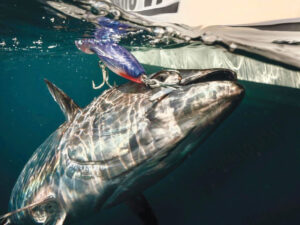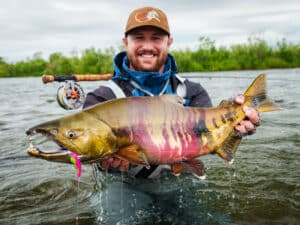
Fat and flat. Those two attributes might not seem desirable to the average man, but come summertime, anglers absolutely go nuts for the saltwater fish that claims those characteristics: summer flounder, aka fluke. Along the mid-Atlantic and Northeast coast, the aggressive predator is the definitive inshore money fish pursued with a passion by anglers for both its fightability and palatability, and even moreso when learned technique and know-how can put scores of doormat-class 8- to 15-pound-caliber trophies into the cooler. Trouble finding the flatties? Don’t fret: Here are some of the best flounder fishing spots on the East Coast during the spring and summer.
Flounder Fishing on the Delaware Coast
Delaware’s artificial-reef program is a boon to marine life by creating structure along a mostly sandy and flat coast. Fourteen separate reef sites exist, nine of which lie inside Delaware Bay, highlighted by Reef Site No. 11, which hosts a whopping 714 Redbird subway cars that provide low-profile structure for fluke to take shelter in and around. Early-season fluke stack up in the shallow waters of the flats in Delaware Bay, especially around Brown Shoal, and the recycled concrete dumps and tugboat wrecks in the 20- to 30-foot depths of the bay, but then move out to the 60- to 80-foot depths of Reef Site No. 10 and No. 11 as well as inside the Delaware Bay in the 45-foot depths of the Anchorage. Serious fluke pros work the area of the B Buoy between the two reef sites to bounce bucktails and top/bottom rigs over the myriad ballast-rock piles dumped by sailing ships of the past, while others set up near the A Buoy in the lower Anchorage to pluck fat flatties.
Top Technique: Drifting top/bottom rigs lanced with killies and bluefish/sea-robin strip baits, bumping lone bucktails tipped with large live killies
Hot Spots: Reef Site No. 11, Brown Shoal, B Buoy, Reef Site No. 10, Lower Anchorage
Who: Capt. Pete Haines, 302-245-4222, topfincharters.com
Captain’s Tip: Work the area of the B Buoy between Reef Site No. 10 and Reef Site No. 11 in springtime as flounder make their move into the Delaware Bay.
Catching Flounder in Cape Cod
Swift currents define the area in and around the Cape and the outer islands that continually push feeding flatfish around with the tides, where they gobble up disoriented schools of baitfish and crustaceans drifting with the flow. The omnipresent currents effectively remove the soft, topical layer of sand, exposing hard, packed-sand shoals as well as more-dense gravel fields where fluke lie in wait. The Cape’s hard-bottom oasis of gravel patches attracts larger-model fluke to root down to pick through bottom-dwelling crabs and chase down squid schools. In order to effectively hold bottom, dedicated fluke hounds target 50- to 80-foot depths of the sound when the water is slack, and then move into the shallows as the current begins to flow during midtide hours.
Top Technique: Bouncing 1- to 6-ounce chrome ball with 5-inch leader fixed with 4-inch swimming mullet along the bottom
Hot Spots: Nantucket Lumps, Vineyard Sound, Lucas Shoal, Iron Pile
Who: Capt. Joe Huckmeyer, 508-790-0660, helen-h.com
Captain’s Tip: Fish the Iron Pile around the commercial conch pots, as traps are set around a submerged barge, and the pot baits, in turn, attract nickel- and dime-size crabs, which fluke then home in on.
Welcome Doormats
Perfect camouflage patterns mimicking a sandy seafloor, a pebble ground or even a rusty wreck are tricks summer flounder use to evade predators or hide in wait for prey, though those crafty patterns will not help them when trying to outwit fluke hunters who are determined to pull them up from the depths and place them in an ice-cold cooler. Follow this guide, and you can hit the top East Coast spots with the right stuff to pull doormats of 8 to 16 pounds, along with a good share of 3- to 7-pounders, this spring and summer.
Flounder Fishing in Long Island, New York
Follow the compass to the North Fork, South Fork and East End, and you’ll find prime fluke haunts in any direction along Long Island. The North Fork branches off into Gardiners Bay and Long Island Sound, while the South Shore in Great South Bay grabs the attention of midisland flounder pounders. Come early May, large-and-in-charge fluke move into Peconic Bay’s prolific grounds, feeding along the mud- and sand-bottom stretches, scattered with shell beds, quarterdeck, mussel and scallop patches, which in turn draw in fluke to feed. Fluke push in and pin grass shrimp and killifish into the three- to four-foot shallows along the beaches of Jessups Neck and Nassau Point on the North Fork, where light-tackle tactics reign supreme to haul up 5-plus-pound flatties.
Top Technique: Drifting a whole 6- to 8-inch squid rigged on three-way swivel, 5-foot section of 40-pound fluorocarbon leader to a sliding snell two-hook rig with 4/0 Baitholder hooks
Hot Spots: Orient Point, ruins off Gardiners Basin, Peconic Bay, South Old Bay, Jessup’s Neck
Who: Capt. Bob Rochetta, 631-445-7088, rainbowcharters.net
Captain’s Tip: Rig a whole squid so it sits straight, one hook in the mantle and the second hook right behind the eyes. Make sure your sliding snell hooks point upward and not downward, so they don’t snag debris on the bottom.
New Jersey Flounder
Deep bayshore channels, 17 artificial reef sites, winding backchannels and hundreds of nearshore wrecks create a top-notch flatfish playground along the Jersey coast. Deep-cut channels like Ambrose Channel in Raritan Bay and Bayshore Channel in Delaware Bay hold doormats during the heat of the mid- to late-summer months, while submarine glacial rock just off the central- and northern-coast beachfronts magnetize fluke to the area in early summer. Most Jersey anglers look for the edges of the “sticky” structure to target their doormats. And as the saying here goes: “If you’re losing rigs, you’re in the right place.” Reef sites comprising Army tanks, tire units and low-profile wrecks attract monster flatfish, while winding six- to 12-foot channels of Barnegat Bay and Ludlam’s Bay are perfect places to battle fluke with light-tackle tactics. Hard bottom, soft bottom, wrecks and channels prove that there’s more at the Shore when it comes to targeting trophy fluke.
Top Technique: Bouncing 3- to 5-ounce bucktails and 1-ounce bucktail teaser combo, tipped with fluke belly; sliding snell two-hook fish-finder rig lanced with 8- to 10-inch fluke belly, mackerel or sea-robin strip baits
Hot Spots: Old Grounds, Elberon Rocks, Raritan Bay/Ambrose Channel, Barnegat Bay/Oyster Creek Channel, Barnegat Light Reef
Who: Capt. Jerry Postorino, 732-688-0765, fishmongercharters.com
Captain’s Tip: Stay tight to structure for big fish, and be prepared to sacrifice bucktails.
And don’t forget to check out our list of the best flounder lures if you’re more into the artificial game.















